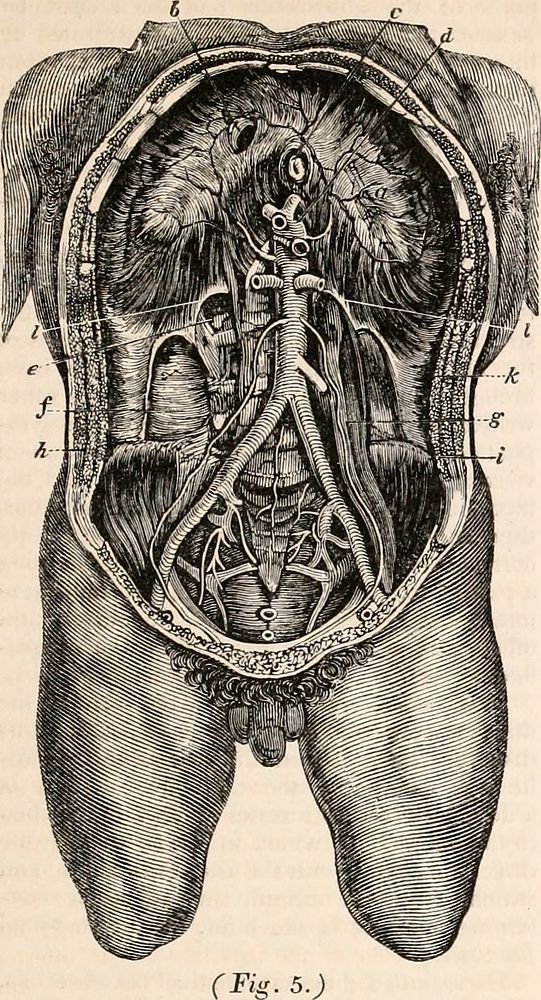https://creativecommons.org/publicdomain/zero/1.0/https://www.rawpixel.com/image/9976791

Title: The cyclopædia of anatomy and physiologyIdentifier: cyclopdiaofana01todd (find matches)Year: 1836 (1830s)Authors: Todd, Robert Bentley, 1809-1860Subjects: Anatomy; Physiology; ZoologyPublisher: London, Sherwood, Gilbert, and PiperContributing Library: MBLWHOI LibraryDigitizing Sponsor: MBLWHOI LibraryView Book Page: Book ViewerAbout This Book: Catalog EntryView All Images: All Images From BookClick here to view book online to see this illustration in context in a browseable online version of this book.Text Appearing Before Image:'Text Appearing After Image:5.) prominent anteriorly, and the continuity of the abdominal and pelvic cavities is thus clearly shewn. It is useful to examine the relations of the axes of these two cavities ; that of the pelvis passes forwards and upwards towards the umbilicus, while the axis of the abdomen passes from above downwards and forwards so as to terminate a little above the pubis, the two axes accordingly would intersect each other a little below the umbilicus at an obtuse angle. This angle may be obliterated by bringing the pelvis very much forward and producing a full flexion of the spine, and hence in all efforts for expulsion that attitude is almost instinctively assumed which shall identify the axes of the two cavities, and thus direct the efforts in the most favourable manner. The ordinary form of the cavity in the adult male is oval, but it presents some slight differences in the female and in the foetus; and these differ- ences are dependent on the great or incomplete development of the pelvis. In the female the abdomen is generally more capacious than in the male ; and this greater size is more remark- able at the inferior part of it in the hypogastric region. In fact in the male it would seem that the great extremity of the oval is toward the thorax, and its smaller one towards the pelvis; but in the female it is just the reverse, the larger extremity being toward the pelvis. It should be observed, however, that the modern ABDOMEN. iy fashion of tightly compressing the lower part of the thorax has a material effect on the external characters of the female abdomen, otherwise there is no reason that the superior part of it should be proportionally less than in the male. In the foetus the abdomen is proportionally larger than at any other period of life: this is to be attributed to the imperfect development of the pelvis, and likewise to the great size which some of the abdominal viscera possess; and as some time must elapse before the pelvis reaches its full dimensions, or the viscera lose their superfluous parts, the abdomen continues of this large size for a long period after birth. The subdivision of the abdomen into regions is especially useful in reference to the contents of the abdominal cavity, which it is highly de- sirable the student should examine, so as to be able to assign to each compartment its appro- priate contents. The abdominal viscera may be subdivided into the membranous and the parenchymatous; the former being such as the stomach and intestinal canal, the latter, such as the liver, spleen, pancreas, &c. The viscera have likewise been distinguished in reference to their position with respect to the peritoneum, by the names' intra-peritojieal and extra-peri- toneal ; but it is sufficient to know that no serous membrane contains any organ within it (i. e. within its sac) to see the error of such a distinction. But we cannot adopt a better di- vision of the abdominal viscera than that which has reference to the functions of those organs, and which Beclard has adopted : viz. 1. the organs of digestion—the stomach, the intes- tinal canal, the liver and its appendages, the spleen, and the pancreas: 2. the urinary organs— the kidneys and the ureters, to which may be added from their close relation to the kid- neys, the suprarenal capsules : 3. the organs of generation in the male—the vasa deferentia, and in the male foetus at the sixth or seventh month of intra-uterine life, the testicles : none of the organs of generation can strictly be said to be abdominal organs in the female. In both male and female the other internal generative organs are pelvic viscera. If we add to the above enumeration of parts the abdominal por- tion of the aorta, its primary subdivision into the common iliacs ; the anterior subdivision of these arteries under the name of external iliacs; the branches of the aorta which are distributed to the viscera as well as to the walls of the abdomen ; the common and external iliac veins; the venacava ascendens; the system of the vena portse ; the abdominal portion of the sympa- thetic system of nerves, both that which follows the arterial ramifications, and that which is the continuation of the chain of ganglia that lies along the spine, the termination of the par vagum; the mesenteric glands, and the lacteals; the lymphatics and their ganglia which lie along the spine; the origin of the thoracic duct, a portion of the course of that duct;—these will complete the list of parts contained in the abdo- minal cavity. The full particulars of the relative positions of the contents of the abdomen, and the abnormal c 2Note About ImagesPlease note that these images are extracted from scanned page images that may have been digitally enhanced for readability - coloration and appearance of these illustrations may not perfectly resemble the original work.
Original public domain image from Wikimedia Commons
Public DomainFree CC0 image for Personal and Business use